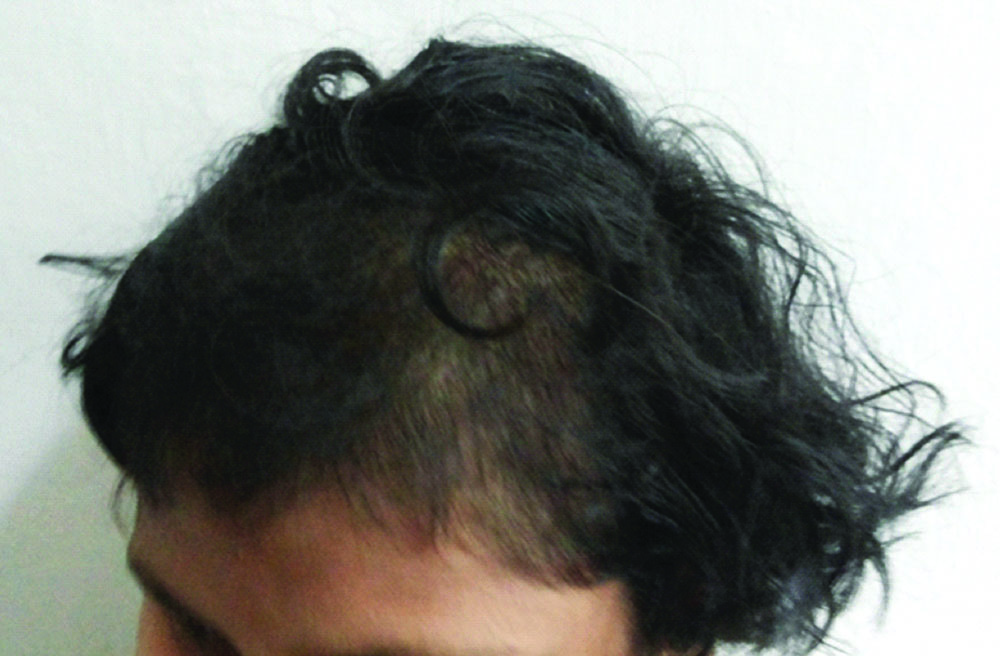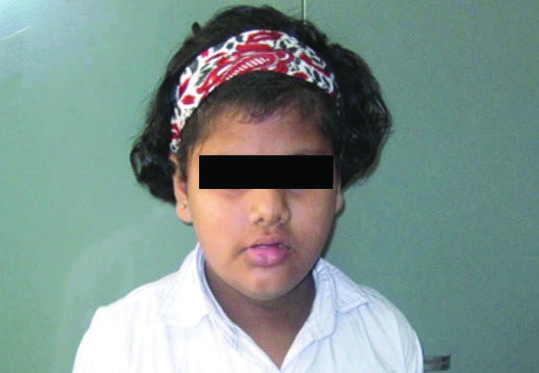Case of Extreme Trichotillomania in a Child with Comorbidities
Tanushree Sahoo1, Krishna Mohan Gulla2, Nuthan Kumar3, Prahbhjot Malhi4
1 Senior Resident, Department of Paediatrics, PGIMER, Chandigarh, India.
2 Senior Resident, Department of Paediatrics, PGIMER, Chandigarh, India.
3 Junior Resident, Department of Paediatrics, PGIMER, Chandigarh, India.
4 Professor, Department of Paediatrics, PGIMER, Chandigarh, India.
NAME, ADDRESS, E-MAIL ID OF THE CORRESPONDING AUTHOR: Tanushree Sahoo, 477, 2nd Floor, Hardevpuri, New Delhi-110094, India.
E-mail: tanushree_sony206@yahoo.co.in
Trichotillomania is an uncommon paediatric psycho-dermatological condition in children. Contrary to the prevalence reported in western literature, it is relatively uncommon in paediatric clinics of Indian subcontinent: mostly due to under reporting because of parental ignorance and associated social stigma. Here, authors report a 10-year-old girl who presented with extreme trichotillomania and other psychological comorbidities like intellectual disability, learning disorders and nocturnal enuresis leading to school absenteeism. She responded well to behavioural therapy without pharmacotherapy. In follow-up at two months, there were no relapses. This case emphasises the recognition of trichotillomania in children and importance of active family participation in successful therapy.
Case Report
A 10-year-old girl, who belonged to a nuclear Hindu family of middle socio-economic status, was referred to child psychology clinic for evaluation of intermittent pulling of hair for two and half years along with nocturnal enuresis and decreased academic performance at school. Her birth history and development history was uneventful prior to this event. She had an unaffected/normal elder sibling. Her relationship with parents and sibling was good.
She developed the symptoms when she saw her mother getting threading of her eyebrows in a beauty parlour. Initial symptoms started as pulling of eyebrows and eyelashes followed by scalp hair in next few weeks. She used to swallow the pulled out hair. However, the family ignored this and no intervention was taken by them initially.
Although during initial months, hair pulling was present in presence of parents, subsequently, it became covert. After two years, symptoms resolved gradually on its own but to restart again three months prior to visiting the clinic. However, this time, the child did not swallow the hair and hair pulling was confined to scalp hair only. Symptom frequency gradually increased from once or twice to multiple times a day over three months that resulted in multiple bald patches over scalp [Table/Fig-1]. The child used to get embarrassed by her bald patches and on certain occasions she would request mother to provide her a hair wig to hide the bald areas. Although sometimes there would be no apparent guilt or sadness. The family used to be extremely distressed and often restricted the child to participate in social gatherings. There was no apparent trigger or stressor for hair pulling.
Frontal alopecia and madarosis secondary to trichotillomanis.

On initial evaluation, child was cooperative with good eye-to-eye contact and psychomotor activity was appropriate. In developmental assessment using Developmental Profile 3, child had a quotient of <70 in all sectors. Her IQ was 69 and SQ was 63. She was also evaluated using Trichotillomania Scale for Children (Parent Version) [1]. Evaluation by dermatology team ruled out common clinical conditions associated with scalp hair loss such as alopecia totalis, taenia versicolor, pressure induced alopecia, nutritional deficiency induced hair loss. She was also evaluated for trichophagy and its related medical complications (trichobezoar).
The child was subjected to multimodality behavioural therapy which consisted of habit reversal therapy, preventing hair pulling by using broad hairband, structuring daily activity/environmental modification (more of stimulating activity and restricting sedentary activity like TV watching) and parental counselling. Habit reversal therapy is the intervention of choice in trichotillomania which consists of- monitoring of frequency of hair pulling, increasing awareness of hair pulling behaviour and situations that aggravate it, stimulus control techniques to prevent or interfere hair pulling, competing response training (doing activities that are physically incompatible with hair pulling) [2].
After four weeks of the first visit, child looked more cheerful and was found to be using a broad hairband [Table/Fig-2]. The mother seemed more involved with child this time in the form of spending more time with the child. Both parents had made a routine for the daily activity, which mainly revolved around making child busy in structured activity, as well as decreased TV watching. On follow-up after two months, mother reported no episode of hair pulling. The child was kept on regular follow-up, as these cases have high recurrence rate in post treatment phase [3].
Follow-up after 4 weeks with broad hairband in place.

Discussion
The present case describes a child with trichotillomania with coexistent intellectual disability and other comorbidities, who responded to combined therapy of habit reversal therapy, parental education and environmental enrichment. This case highlights the effectiveness of combined habit reversal technique along with environment change in treatment of paediatric trichotillomania.
Trichotillomania is a psycho-dermatological disorder characterised by clinically significant hair loss secondary to non-cosmetic pulling of hair. The name is derived from the Greek terms for hair (trich), pulling (tillo) and morbid impulse (mania). The disorder was first recognised by Diagnostic and Statistical Manual of the American Psychiatric Association, third edition-revised (DSM-III-R) in 1987. According to current DSM V classification, it is recognised as one of the Obsessive compulsion disorder (OCD) [4]. However, unlike typical OCD, trichotillomania is more common in girls and is usually not associated with disturbances in serotoninergic pathway. There is paucity of literature regarding exact prevalence of trichotillomania in general population. In developed countries, it is estimated to be nearly in 1-3% of adolescent and young adult age group [5]. True prevalence is actually higher than the reported cases as milder cases are benign self-limited problem in children, hence rarely reported in clinics. Data on this condition from Indian set up is very limited [6-12]. A chart review from the present authors’ institute in adult population revealed a prevalence of 1.25% [12]. Studies on pharmacotherapy remain inconsistent and none of the drugs are found to be more effective as compared to placebo. Pharmacotherapy is generally reserved for resistant cases. Habit reversal therapy has been found to be the most effective of all modalities of treatment even in paediatric population [13].
Trichotillomania is known to be associated with psychological comorbidities such as intellectual disability, depression, anxiety disorders, specific learning disability, enuresis and physical comorbidities like trichophagia, trichobezoar, scalp abscess [14-16]. The index case also had comorbidities such as nocturnal enuresis; learning disability and intellectual disability for which she was kept under regular follow-up. Some of the measures taken for addressing comorbidities were: behavioural therapy (rewarding the child for dry nights) and fluid restriction at night for nocturnal enuresis and multisensory stimulation for intellectual disability.
Trichophagy is reported in more than half of the cases with trichotillomania [16]. Hence, special attention should be provided to rule out trichophagy and trichobezoar in all cases of extreme trichotillomania. In the index case, we had taken detailed history to rule out trichophagy and moreover USG abdomen did not reveal any trichobezoar. Parents and primary care givers play a cornerstone role in management of paediatric trichotillomania. Hence responsibility of treating physician/psychologist is to involve them actively in therapy [12,17]. Educated parents are advised to go through webpages dedicated for trichotillomania and refer the health awareness material available in that web site.
Conclusion
Paediatric trichotillomania is often an ignored entity in developing countries which needs to be addressed systematically through principles of habit reversal therapy and active involvement of parents. As more and more such cases are being diagnosed now-a-days, there is a need to create awareness about this entity among paediatricians.
[1]. Tolin DF, Diefenbach GJ, Flessner CA, Franklin ME, Keuthen NJ, Moore P, The Trichotillomania Scale for Children: Development and Validation Child Psychiatry Hum Dev 2008 39(3):331-49.10.1007/s10578-007-0092-318183484 [Google Scholar] [CrossRef] [PubMed]
[2]. Bloch MH, Landeros-Weisenberger A, Dombrowski P, Kelmendi B, Wegner R, Nudel J, Systematic review: pharmacological and behavioural treatment for trichotillomania Biol Psychiatry 2007 62(8):839-46.10.1016/j.biopsych.2007.05.01917727824 [Google Scholar] [CrossRef] [PubMed]
[3]. Falkenstein MJ, Rogers K, Malloy EJ, Haaga DAF, Predictors of relapse following treatment of trichotillomania J Obsessive-Compuls Relat Disord 2014 3(4):345-53.10.1016/j.jocrd.2014.09.00125405081 [Google Scholar] [CrossRef] [PubMed]
[4]. American Psychiatric Association Diagnostic and Statistical Manual of Mental Disorders [Internet] 2013 Fifth EditionAmerican Psychiatric AssociationAvailable from: https://psychiatryonline.org/doi/book/10.1176/appi.books.978089042559610.1176/appi.books.9780890425596 [Google Scholar] [CrossRef]
[5]. Christenson GA, Pyle RL, Mitchell JE, Estimated lifetime prevalence of trichotillomania in college students J Clin Psychiatry 1991 52(10):415-17. [Google Scholar]
[6]. Gupta S, Gargi P, Habit reversal training for trichotillomania Int J Trichology 2012 4(1):3910.4103/0974-7753.9608922628990 [Google Scholar] [CrossRef] [PubMed]
[7]. Gupta A, Kaur J, Wadhwa N, Rapunzel syndrome in a seven-year-old female Turk J Paediatr 2017 59(5):598-600.10.24953/turkjped.2017.05.01629745125 [Google Scholar] [CrossRef] [PubMed]
[8]. Mitra S, Kavoor AR, Yadav N, “The girl who pulled her hair”-Positive-affect trichotillomania in a 2-year old child Asian J Psychiatry 2017 28:179-80.10.1016/j.ajp.2017.06.00528784383 [Google Scholar] [CrossRef] [PubMed]
[9]. Kumar D, Singh H, Trivedi JK, Trichotillomania-a brief review and case report Indian J Psychiatry 1982 24(1):95-98. [Google Scholar]
[10]. Agarawal SM, Divakara PG, Pramanik KB, Trichotillomania in depression-a case report Indian J Psychiatry 1988 30(4):423-25. [Google Scholar]
[11]. Kaur H, Chavan BS, Raj L, Management of trichotillomania Indian J Psychiatry 2005 47(4):235-37.10.4103/0019-5545.4306320711315 [Google Scholar] [CrossRef] [PubMed]
[12]. Malhotra S, Grover S, Baweja R, Bhateja G, Trichotillomania in children Indian Paediatr 2008 45(5):403-05. [Google Scholar]
[13]. Sah DE, Koo J, Price VH, Trichotillomania Dermatol Ther 2008 21(1):13-21.10.1111/j.1529-8019.2008.00165.x18318881 [Google Scholar] [CrossRef] [PubMed]
[14]. Klobučar A, Folnegović-Šmalc V, Kocijan-Hercigonja D, Sovič S, Gulič L, Clinical characteristics and comorbidities of paediatric trichotillomania: the study of 38 cases in Croatia Psychiatr Danub 2018 30(1):79-84.10.24869/psyd.2018.7929546862 [Google Scholar] [CrossRef] [PubMed]
[15]. Grzesiak M, Reich A, Szepietowski JC, Hadryś T, Pacan P, Trichotillomania among young adults: prevalence and comorbidity Acta Derm Venereol 2017 97(4):509-12.10.2340/00015555-256527827514 [Google Scholar] [CrossRef] [PubMed]
[16]. Christenson GA, Mackenzie TB, Mitchell JE, Characteristics of 60 adult chronic hair pullers Am J Psychiatry 1991 148(3):36510.1176/ajp.148.3.3651992841 [Google Scholar] [CrossRef] [PubMed]
[17]. Murphy YE, Flessner CA, Family functioning in paediatric obsessive compulsive and related disorders Br J Clin Psychol 2015 54(4):414-34.10.1111/bjc.1208826017183 [Google Scholar] [CrossRef] [PubMed]